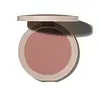What's inside
What's inside
 Key Ingredients
Key Ingredients

 Benefits
Benefits

 Concerns
Concerns

 Ingredients Side-by-side
Ingredients Side-by-side

C12-15 Alkyl Ethylhexanoate
EmollientZinc Stearate
Cosmetic ColorantMethyl Methacrylate/Glycol Dimethacrylate Crosspolymer
Alumina
AbrasiveLauroyl Lysine
Skin ConditioningPentaerythrityl Tetraethylhexanoate
EmollientCaprylyl Glycol
EmollientWater
Skin ConditioningBisabolol
MaskingPanthenyl Triacetate
Hexylene Glycol
EmulsifyingTriethoxycaprylylsilane
Silica
AbrasiveBHT
AntioxidantPotassium Sorbate
PreservativePhenoxyethanol
PreservativeFarnesyl Acetate
PerfumingFarnesol
PerfumingMica
Cosmetic ColorantCI 77891
Cosmetic ColorantCI 77491
Cosmetic ColorantCI 77492
Cosmetic ColorantCI 77499
Cosmetic ColorantCI 77007
Cosmetic ColorantCI 75470
Cosmetic ColorantCI 19140
Cosmetic ColorantC12-15 Alkyl Ethylhexanoate, Zinc Stearate, Methyl Methacrylate/Glycol Dimethacrylate Crosspolymer, Alumina, Lauroyl Lysine, Pentaerythrityl Tetraethylhexanoate, Caprylyl Glycol, Water, Bisabolol, Panthenyl Triacetate, Hexylene Glycol, Triethoxycaprylylsilane, Silica, BHT, Potassium Sorbate, Phenoxyethanol, Farnesyl Acetate, Farnesol, Mica, CI 77891, CI 77491, CI 77492, CI 77499, CI 77007, CI 75470, CI 19140
Mica
Cosmetic ColorantZea Mays Starch
AbsorbentPolyethylene
AbrasiveZinc Stearate
Cosmetic ColorantTricaprylin
MaskingSilica
AbrasiveWater
Skin ConditioningCaprylic/Capric Triglyceride
MaskingSodium Dehydroacetate
PreservativePhenoxyethanol
PreservativeSorbic Acid
PreservativeAluminum Dimyristate
Emulsion StabilisingTriethoxycaprylylsilane
Disodium Stearoyl Glutamate
CleansingCI 77742
Cosmetic ColorantCI 77491
Cosmetic ColorantTin Oxide
AbrasiveCI 77891
Cosmetic ColorantIngredients Explained
These ingredients are found in both products.
Ingredients higher up in an ingredient list are typically present in a larger amount.
Ci 77491 is also hydrated iron III oxide. It's sole purpose is to give a red/pink hue to products.
Iron III oxides are classified as inorganic chemicals for coloring.
Synthetically created Ci 77491 is considered safer than those naturally found. This is because the synthetically created version may contain less impurities. Iron oxides are generally non-toxic and non-allergenic.
Learn more about CI 77491Ci 77891 is a white pigment from Titanium dioxide. It is naturally found in minerals such as rutile and ilmenite.
It's main function is to add a white color to cosmetics. It can also be mixed with other colors to create different shades.
Ci 77891 is commonly found in sunscreens due to its ability to block UV rays.
Learn more about CI 77891Mica is a naturally occurring mineral used to add shimmer and color in cosmetics. It can also help improve the texture of a product or give it an opaque, white/silver color.
Serecite is the name for very fine but ragged grains of mica.
This ingredient is often coated with metal oxides like titanium dioxide. Trace amounts of heavy metals may be found in mica, but these metals are not harmful in our personal products.
Mica has been used since prehistoric times throughout the world. Ancient Egyptian, Indian, Greek, Roman, Aztec, and Chinese civilizations have used mica.
Learn more about MicaPhenoxyethanol is a preservative that has germicide, antimicrobial, and aromatic properties. Studies show that phenoxyethanol can prevent microbial growth. By itself, it has a scent that is similar to that of a rose.
It's often used in formulations along with Caprylyl Glycol to preserve the shelf life of products.
Silica, also known as silicon dioxide, is a naturally occurring mineral. It is used as a fine, spherical, and porous powder in cosmetics.
Though it has exfoliant properties, the function of silica varies depending on the product.
The unique structure of silica enhances the spreadability and adds smoothness, making it a great texture enhancer.
It is also used as an active carrier, emulsifier, and mattifier due to its ability to absorb excess oil.
In some products, tiny microneedles called spicules are made from silica or hydrolyzed sponge. When you rub them in, they lightly polish away dead skin layers and enhance the penetration of active ingredients.
Learn more about SilicaTriethoxycaprylylsilane is a silicone used to bind and stabilize ingredients.
As an emulsifier, it helps prevent ingredients from separating. This can help elongate the shelf life of products.
Triethoxycaprylylsilane is often used to coat mineral sunscreens ingredients to help give a better feel. It also helps reduce oxidative stress in sunscreens.
Learn more about TriethoxycaprylylsilaneWater. It's the most common cosmetic ingredient of all. You'll usually see it at the top of ingredient lists, meaning that it makes up the largest part of the product.
So why is it so popular? Water most often acts as a solvent - this means that it helps dissolve other ingredients into the formulation.
You'll also recognize water as that liquid we all need to stay alive. If you see this, drink a glass of water. Stay hydrated!
Learn more about WaterZinc Stearate is the metal salt of stearic acid. It is a white solid used to bind, thicken, and lubricate products.
This ingredient is common in powder makeup, where it helps keep the powder together.
Zinc Stearate is hydrophobic and repels water.
This ingredient can be sourced from non-animal or animal sources. It is best to reach out to the brand to see where they source this ingredient from.
Learn more about Zinc Stearate